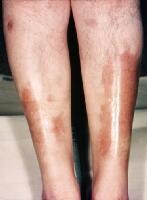question 170-179
Erythema Multiforme (EM)
an acute, self-limited, and sometimes recurring skin condition that is considered to be a type IV hypersensitivity reaction associated with certain infections, medications, and other various triggers.
causes, HSV and infections, drugs(More than 50% of cases are related to medication use,sulfa drugs are the most common triggers (30%),
treatment: For all forms of erythema multiforme (EM), the most important treatment is usually symptomatic, including oral antihistamines, analgesics, local skin care, and soothing mouthwashes (eg, oral rinsing with warm saline or a solution of diphenhydramine, xylocaine, and kaopectate). Topical steroids may be considered.
the cause of the erythema multiforme should be identified, if possible. If a drug is suspected, it must be withdrawn as soon as possible. This includes all medications begun during the preceding 2 months.
necrobius lipodica
a disorder of collagen degeneration with a granulomatous response, thickening of blood vessel walls, and fat deposition. The main complication of the disease is ulceration
strong relationship between diabetes and necrobiosis lipoidica, A deposition of glycoprotein in blood vessel walls may be the cause of diabetic microangiopathy.

acanthosis nigrans
Acanthosis nigricans can affect otherwise healthy people, or it can be associated with certain medical conditions. Sometimes acanthosis nigricans is congenital (something a person is born with). It also can occur as a result of obesity or an endocrine (glandular) disorder.
- Addison's disease, a condition caused by a deficiency of hormones from the adrenal gland
- Disorders of the pituitary gland within the brain
- Growth hormone therapy
- Hypothyroidism (low levels of thyroid hormone caused by decreased activity of the thyroid gland)
- Oral contraceptives
- Insulin resistance. Most people who have acanthosis nigricans have also become resistant to insulin, a hormone secreted by the pancreas that allows your body to process sugar. Insulin resistance is what eventually causes type 2 diabetes.
- Obesity. Most people who develop acanthosis nigricans are overweight or obese, which is a strong risk factor for developing insulin resistance.
- Hormonal disorders. Acanthosis nigricans often occurs in people who have disorders such as ovarian cysts, underactive thyroids or problems with the adrenal glands.
- Certain drugs. Medications such as oral contraceptives and corticosteroids, such as prednisone, may cause acanthosis nigricans — as can high doses of niacin.
- Cancer. Acanthosis nigricans also sometimes occurs when a cancerous tumor begins growing in an internal organ, such as the stomach, colon or liver.
Most people with acanthosis nigricans have an insulin level that is higher than that of people of the same weight who don't have acanthosis nigricans.
Rarely, people with certain types of cancer can also develop acanthosis nigricans.
coarctation of the aorta
Symptomatic or medical failure – surgery (not this case)
Asymptomatic (this case) – avoid surgery as long as you can.
Asymptomatic adults with coarctation of aorta have normal life expectancy without surgery if their blood pressure is under control.
| Biliary Colic | Cholecystitis | |
Investigations
Initial Management
Continuing Management
|
|
没有评论:
发表评论